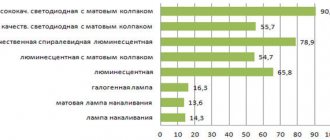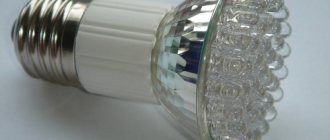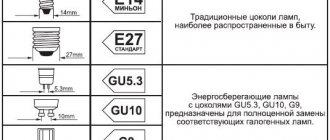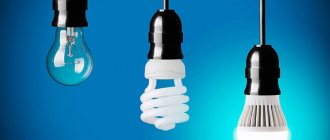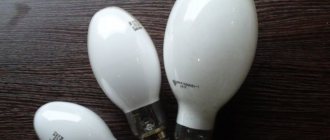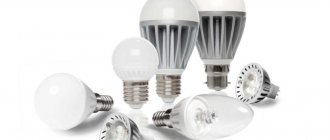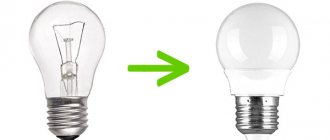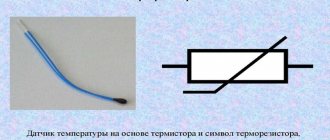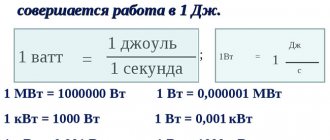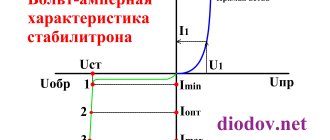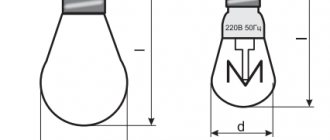The incandescent lamp is the first electric lighting device that plays an important role in human life. It is this that allows people to go about their business regardless of the time of day.
Compared to other light sources, this device is characterized by simplicity of design. The luminous flux is emitted by a tungsten filament located inside a glass bulb, the cavity of which is filled with a deep vacuum. Later, to increase durability, instead of vacuum, special gases began to be pumped into the flask - this is how halogen lamps appeared. Tungsten is a heat-resistant material with a high melting point. This is very important, because in order for a person to see the glow, the thread must become very hot due to the current passing through it.
History of creation
Interestingly, the first lamps did not use tungsten, but a number of other materials, including paper, graphite and bamboo. Therefore, despite the fact that all the laurels for the invention and improvement of the incandescent lamp belong to Edison and Lodygin, it is wrong to attribute all the merits only to them.
We will not write about the failures of individual scientists, but we will give the main directions in which the efforts of the men of that time were made:
- The search for the best filament material. It was necessary to find a material that was both resistant to fire and characterized by high resistance. The first thread was created from bamboo fibers, which were covered with a thin layer of graphite. Bamboo acted as an insulator, graphite as a conductive medium. Since the layer was small, the resistance increased significantly (as required). Everything would be fine, but the wood base of the coal led to rapid ignition.
- Next, the researchers thought about how to create conditions of the strictest vacuum, because oxygen is an important element for the combustion process.
- After this, it was necessary to create the connector and contact components of the electrical circuit. The task was complicated by the use of a layer of graphite, which is characterized by high resistance, so the scientists had to use precious metals - platinum and silver. This increased the current conductivity, but the cost of the product was too high.
- It is noteworthy that the Edison base thread is still used to this day - marked E27. The first methods of creating a contact involved soldering, but in this situation today it would be difficult to talk about quickly replaceable light bulbs. And with strong heating, such compounds would quickly disintegrate.
Nowadays, the popularity of such lamps is falling exponentially. In 2003, in Russia the amplitude of the supply voltage was increased by 5%; today this parameter is already 10%. This led to a reduction in the life of the incandescent lamp by 4 times. On the other hand, if you return the voltage to an equivalent value down, the luminous flux output will be significantly reduced - up to 40%.
Remember the training course - back in school, a physics teacher conducted experiments demonstrating how the glow of a lamp increases with increasing current supplied to the tungsten filament. The higher the current, the stronger the emission of radiation and the more heat.
Operating principle
The principle of operation of the lamp is based on the strong heating of the filament due to the electric current passing through it. In order for a solid material to begin to emit a red glow, its temperature must reach 570 degrees. Celsius. The radiation will be pleasant to the human eye only if this parameter is increased by 3–4 times.
Few materials are characterized by such refractoriness. Due to the affordable pricing policy, the choice was made in favor of tungsten, whose melting point is 3400 degrees. Celsius. To increase the area of light emission, the tungsten filament is twisted into a spiral. During operation, it can heat up to 2800 degrees. Celsius. The color temperature of such radiation is 2000–3000 K, which gives a yellowish spectrum - incomparable with daylight, but at the same time does not have a negative effect on the visual organs.
Once in the air, tungsten quickly oxidizes and breaks down. As mentioned above, instead of a vacuum, a glass flask can be filled with gases. We are talking about inert nitrogen, argon or krypton. This allowed not only to increase durability, but also to increase the glow strength. The service life is affected by the fact that gas pressure prevents the evaporation of the tungsten filament due to the high glow temperature.
Best before date
The service life of a product depends on its quality. LN should be stored in a cardboard box. This is necessary so as not to accidentally break it or so that it does not give an imperceptible crack that will ruin the whole work. Because of such a crack, the gas will evaporate; as a result, after the light bulb is screwed into the lampshade, it will work for no more than 2-3 hours. You must follow safety rules when screwing the lamp into the lampshade. Children should not be allowed to participate in this process, and it is also advisable to completely turn off the electricity supply in the room.
Note! Used light bulbs must be disposed of properly and should not be thrown away with food waste. Every city has special bins for such waste.
If you follow all the rules of storage and use, the lamp will last as long as possible, without defects.
Vintage Edison lamp
Structure
A typical lamp consists of the following structural elements:
- flask;
- vacuum or inert gas pumped inside it;
- filament;
- electrodes - current terminals;
- hooks needed to hold the filament;
- leg;
- fuse;
- base, consisting of a housing, an insulator and a contact on the bottom.
In addition to standard versions made of conductor, glass vessel and leads, there are lamps for special purposes. Instead of a base, they use other holders or add an additional bulb.
The fuse is usually made of an alloy of ferrite and nickel and is placed in the gap on one of the current terminals. Often it is located in the leg. Its main purpose is to protect the flask from destruction in the event of a thread break. This is due to the fact that if it breaks, an electric arc is formed, leading to the melting of the remnants of the conductor, which fall on the glass bulb. Due to the high temperature, it may explode and cause a fire. However, for many years the low efficiency of fuses has been proven, so they are used less frequently.
Flask
The glass vessel is used to protect the filament from oxidation and destruction. The overall dimensions of the flask are selected depending on the deposition rate of the material from which the conductor is made.
Gas environment
If previously all incandescent lamps without exception were filled with vacuum, today this approach is used only for low-power light sources. More powerful devices are filled with inert gas. The molar mass of the gas affects the heat emitted by the filament.
Halogens are pumped into the bulb of halogen lamps. The substance with which the filament is coated begins to evaporate and interact with the halogens located inside the vessel. As a result of the reaction, compounds are formed that decompose again and the substance returns to the surface of the thread. Thanks to this, it became possible to increase the temperature of the conductor, increasing the efficiency and service life of the product. This approach also made it possible to make the flasks more compact. The design flaw is associated with the initially low resistance of the conductor when applying electric current.
Filament
The shape of the filament can be different - the choice in favor of one or the other depends on the specifics of the light bulb. They often use a thread with a round cross-section, twisted into a spiral, and much less often - ribbon conductors.
A modern incandescent lamp is powered by a filament made of tungsten or an osmium-tungsten alloy. Instead of conventional helices, bi-helices and tri-helices can be twisted, which is made possible by repeated twisting. The latter leads to a decrease in thermal radiation and an increase in efficiency.
Specifications
It is interesting to observe the relationship between light energy and lamp power. The changes are not linear - up to 75 W, the luminous efficiency increases, and if it is exceeded, it decreases.
One of the advantages of such light sources is uniform illumination, since light is emitted with equal strength in almost all directions.
Another advantage is associated with pulsating light, which at certain values leads to significant eye fatigue. The normal value is considered to be a ripple coefficient not exceeding 10%. For incandescent lamps the maximum parameter reaches 4%. The worst indicator is for products with a power of 40 W.
Of all the electrical lighting available, incandescent bulbs run the hottest. Most of the current is converted into thermal energy, so the device is more like a heater than a light source. Luminous efficiency ranges from 5 to 15%. For this reason, the legislation contains certain rules prohibiting, for example, the use of incandescent lamps of more than 100 W.
Typically, a 60 W lamp is enough to illuminate one room, which is characterized by slight heating.
When considering the emission spectrum and comparing it with natural light, two important observations can be made: the luminous flux of such lamps contains less blue and more red light. However, the result is considered acceptable and does not lead to fatigue, as is the case with daylight sources.
Operating Parameters
When using incandescent lamps, it is important to consider the conditions of their use. They can be used indoors and outdoors at temperatures not less than –60 and not more than +50 degrees. Celsius. In this case, air humidity should not exceed 98% (+20 degrees Celsius). The devices can operate in the same circuit with dimmers designed to regulate light output by changing the light intensity. These are cheap products that can be replaced independently even by an unqualified person.
Towards an energy efficient future
With energy resources dwindling, the world is struggling to conserve them and move towards more sustainable solutions. The best artificial lighting option you can choose is LED lighting due to the numerous benefits it has over other traditional lighting methods. LED bulbs emit little heat energy, last up to 25,000 hours, and are available in a variety of colors.
The future of residential and commercial lighting is very bright, thanks to mankind's brilliant inventors who are always on the lookout for new technologies!
Kinds
There are several criteria for classifying incandescent lamps, which will be discussed below.
Depending on the lighting efficiency, incandescent lamps are classified (from worst to best):
- vacuum;
- argon or nitrogen-argon;
- krypton;
- xenon or halogen with an infrared reflector installed inside the lamp, which increases efficiency;
- with a coating designed to convert infrared radiation into the visible spectrum.
There are many more varieties of incandescent lamps related to their functional purpose and design features:
- General purpose - in the 70s. of the last century they were called “normal lighting lamps”. The most common and numerous category is products used for general and decorative lighting. Since 2008, the production of such light sources has decreased significantly, which was due to the adoption of numerous laws.
- Decorative purpose. The flasks of such products are made in the form of graceful figures. The most common types are candle-shaped glass vessels with a diameter of up to 35 mm and spherical ones (45 mm).
- Local appointment. The design is identical to the first category, but they are powered by a reduced voltage - 12/24/36/48 V. They are usually used in portable lamps and devices that illuminate workbenches, machines, etc.
- Illumination with painted bulbs. Often the power of products does not exceed 25 W, and for coloring the internal cavity is covered with a layer of inorganic pigment. It is much less common to find light sources whose outer part is painted with colored varnish. In this case, the pigment fades and crumbles very quickly.
- Mirrored. The bulb is made in a special shape, which is covered with a reflective layer (for example, by spraying aluminum). These products are used to redistribute the light flux and increase lighting efficiency.
- Signal. They are installed in lighting products intended to display any information. They are characterized by low power and are designed for long-term operation. Today they are practically useless due to the availability of LEDs.
- Transport. Another broad category of lamps used in vehicles. Characterized by high strength and vibration resistance. They use special bases that guarantee strong fastening and the ability to quickly replace them in cramped conditions. Can be powered from 6 V.
- Spotlights. High-power light sources up to 10 kW, characterized by high luminous efficiency. The spiral is laid compactly to ensure better focusing.
- Lamps used in optical devices, for example, film projection or medical equipment.
Special lamps
There are also more specific types of incandescent lamps:
- Switchboards are a subcategory of signal lamps used in switchboards and performing the functions of indicators. These are narrow, oblong and small-sized products with smooth parallel contacts. Due to this, they can be placed in buttons. Marked as “KM 6-50”. The first number indicates the voltage, the second indicates the amperage (mA).
- Incandescent or photographic lamp. These products are used in photographic equipment for normalized forced mode. It is characterized by high luminous efficiency and color temperature, but a short service life. The power of Soviet lamps reached 500 W. In most cases, the flask is frosted. Today they are practically not used.
- Projection. Used in slide projectors. High brightness.
The double-filament lamp comes in several varieties:
- For cars. One thread is used for the low beam, the other for the high beam. If we consider lamps for rear lights, then the threads can be used for the brake light and side light, respectively. An additional screen can cut off rays that in the low beam lamp can blind oncoming drivers.
- For airplanes. In a landing light, one filament can be used for low light, the other for high light, but requires external cooling and short operation.
- For railway traffic lights. Two threads are necessary to increase reliability - if one burns out, the other will glow.
Let's continue to consider special incandescent lamps:
- A headlight lamp is a complex design for moving objects. Used in automotive and aviation technology.
- Low inertia. Contains a thin filament. It was used in optical-type sound recording systems and in some types of phototelegraphy. Nowadays it is rarely used, since there are more modern and improved light sources.
- Heating. Used as a heat source in laser printers and copiers. The lamp has a cylindrical shape, is fixed in a rotating metal shaft, to which paper and toner are applied. The roller transfers heat, causing the toner to spread.
Efficiency
Electric current in incandescent lamps is converted not only into light visible to the eye. One part is used for radiation, the other is transformed into heat, and the third is converted into infrared light, which is not detected by the visual organs. If the conductor temperature is 3350 K, then the efficiency of the incandescent lamp will be 15%. A conventional 60 W lamp with a temperature of 2700 K is characterized by a minimum efficiency of 5%.
The efficiency is enhanced by the degree of heating of the conductor. But the higher the heating of the filament, the shorter the service life. For example, at a temperature of 2700 K, a light bulb will illuminate for 1000 hours, at 3400 K - several times less. If you increase the supply voltage by 20%, the glow will double. This is irrational, since the service life will be reduced by 95%.
Advantages of incandescent lamps
The main advantages of incandescent lamps:
- compact dimensions and stable color spectrum of radiation;
- no additional unit is required to ignite and support the operation of the product;
- simple design and proven manufacturing technology, which have a positive effect on cost;
- the glow is not sensitive to the effects of ionizing radiation and electromagnetic pulses;
- the design of the spiral allows voltage surges;
- when voltage is applied, the lamp turns on instantly;
- the product design does not use toxic substances that require special conditions for disposal or processing;
- can be used in DC and AC networks;
- when switching, polarity does not matter;
- the design design allows the production of equipment designed for different supply voltages;
- it is possible to adjust the brightness of the glow using additional resistance (dimmer);
- when switching to the AC network there is no light pulsation;
- there is no buzzing or other extraneous noise during operation;
- operation at negative temperatures is allowed;
- during operation there is no interference that interferes with the reception of radio waves;
- resistance of the structure to the formation of condensation.
Advantages and disadvantages
On the one hand, incandescent lamps are the most affordable light sources, on the other hand, they are characterized by a lot of disadvantages.
Advantages:
- low cost;
- there is no need to use additional devices;
- ease of use;
- comfortable color temperature;
- resistance to high humidity.
Flaws:
- fragility - 700–1000 hours if all rules and operating recommendations are followed;
- weak light output - efficiency from 5 to 15%;
- fragile glass flask;
- possibility of explosion if overheated;
- high fire danger;
- Voltage drops significantly shorten the service life.
Scope of use
Incandescent lamps are used in a wide variety of areas of human activity. It is difficult to even imagine a place or device where they would not be used. Starting from ordinary household lighting of residential premises, to the organization of light signaling, from a pocket flashlight, to the most powerful military searchlights. And although modern technologies do not stand still offering new lighting sources, in many cases “classic” light bulbs do not have an equivalent replacement. This popularity is understandable - they are inexpensive, easy to install and operate.
